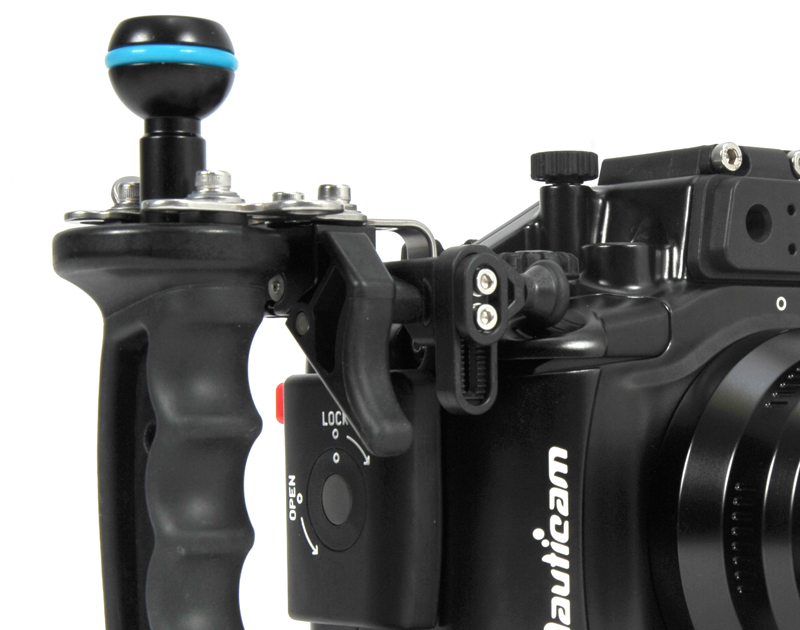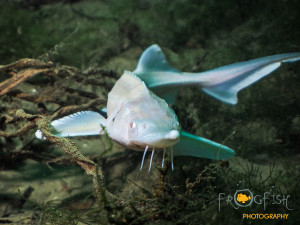News
S.U.P.E.R. Part 9: Nauticam NA-EM10II

In our ongoing series S.U.P.E.R. (Scubaverse’s Underwater Photography Equipment Reviews), Nick and Caroline Robertson Brown from Frogfish Photography review new underwater photography equipment, general diving equipment, and some older favourites too.
For the ninth instalment of S.U.P.E.R., Nick and Caroline take a look at the NA-EM10 Housing from Nauticam.
Nauticam have added the latest housing for the Olympus EM10 mkII to their extensive range of underwater camera housings.
The first thing we noticed when getting it out of its box was how light it was. Okay, we are used to heavier SLR housings, but this is very light (at just a touch over 1kg), and indeed compact in size too. The Olympus mirrorless cameras are probably the most popular – of this genre – with underwater photographers, due to the quality of the cameras and the range of lenses available for them. Nauticam has made a housing that ensures that you can access every function with ease, and has port and gear options to allow users to have a great choice on what to buy. The housing is tough and is made from solid aluminium with a depth rating of 100m, which makes it suitable for technical diving too.
It is always difficult to test a new housing, with an unfamiliar camera inside, with only one day to dash up to Capernwray Quarry, in freezing conditions, and get the best from the system. Cold hands combined with unfamiliarity with the camera itself can lead to frustration. However, Nauticam housings do help, with an intuitive design, a sturdy build and some great extras. One of the first things that really pleased us about this housing was the new Shutter Release Extension. This is a piece that can be fitted to the housing that makes the shutter release easy to press (even with 5mm gloves) without moving your hand away from holding the handle. This new housing also comes with metal brackets that anchor the handles from the tray system to the housing – giving better stability all around.
This new housing and ports are also designed to take the fantastic new wet lenses that Nauticam have brought out and so, with the Compact Macro Converter (CMC) attached to a holder on the arm, and the Wet Wide Lens (WWL-1) attached to the bayonet fitting on the port, we were ready for action. The WWL-1 is a heavy wet lens, as you would expect from a quality piece of glass, and so you can also get a handy float for the housing that keeps the system nicely balanced in the water.
With these optional Nauticam wet lenses, you can actually stick with the “kit” 14-42mm lens and the small Macro 29 port and take amazing images. However, there are also great lenses for the Olympus range for both macro and wide angle lovers to select from.
Whilst the Nauticam Vacuum Leak Detector is not a new feature specifically for this housing, as it has been around for a while now, it does come with the ability to have one fitted. This feature really does give you peace of mind, as it tests the integrity of housing seals before you get into the water. A green light and you are good to go.
It is hard not to be impressed with Nauticam housings and this is no exception. It looks good, feels good in the hand, and is obviously built to a high standard. With some fabulous accessories, a great choice of lenses, ports and gears to select from, the hardest thing for buyers will be what to leave out of the package! Whilst we only got a single, cold water dive to form our views, we are certain this is a product that will not disappoint. Actually we would quite like it back!
For more information regarding Nauticam products visit www.nauticam.co.uk.
To find out more about Nick and Caroline and Frogfish Photography, visit www.frogfishphotography.com.
Gear News
Introducing the TR-80, IR-50 and CS-30 Regulators from DYNAMICNORD

Whether you are a beginner or a professional diver – with the three new main regulators from DYNAMICNORD, everyone will find their favourite regulator. They all look super stylish.
Excellent performance with the TR-80
Quality and performance are the be-all and end-all for regulators. It is not for nothing that the TR stands for Tec Reg. The innovative design of the TR-80 guarantees absolute reliability – even in ice-cold waters.

Perfect breathing effort at 0.8 J/l / certified for diving in waters below 10 degrees / structural design made of solid brass for best cold protection / membrane-compensated design with dry seal of the first stage / reduced exhalation effort thanks to optimized exhalation membrane and bubble deflector / adjustable Venturi (dive/predive) and adjustment knob for individual inhalation comfort / innovative design of the front cover prevents free-flow in strong currents or when diving with scooters / design made of sandblasted brass, matt chrome finish / 2 HP and 4 LP outlets / mouthpiece made of high-quality, anti-allergic silicone for maximum comfort.


Amazing underwater adventures with the IR-50
The IR-50 is the top regulator for advanced and experienced divers. Natural breathing is the essence of this regulator.

Ideal breathing effort at 0.8 J/l /certified for diving in waters below 10 degrees / compensated membrane / adjustable venturi (dive/predive) and adjustment knob for individual inhalation comfort/ outlet valve and deflector for minimum exhalation effort and reduction of bubbles on the face / design made of sandblasted brass, matt chrome finish / 2 HP and 4 NP outlets / mouthpiece made of high-quality, anti-allergic silicone for maximum comfort.


The Workhorse – our CS-30
For diving centres and diving beginners – the workhorse stands for strong construction, reliability and robustness. Perfect for your training.

Optimal breathing effort at 0.8 J/l /recommended for diving in waters above 10 degrees / non-compensated piston / adjustable venturi (dive/predive) / outlet valve and deflector for minimum exhalation effort and reduction of bubbles on the face / design made of sandblasted brass, matt chrome finish / 1 HP and 3 NP outlets / mouthpiece made of high-quality, anti-allergic silicone for maximum comfort.


Octopus OP-30
The OP-30 is the ideal addition to all DYNAMICNORD regulators. It is identical in construction to the CS-30.

The TR-80, IR-50, CS-30 (DIN & INT) regulators and the Octopus OP-30 are available from DYNAMICNORD dealers and in the online store.
DYNAMICNORD – Your Outdoor Companion.
Marine Life & Conservation
Paul Watson Released as Denmark Blocks Japan’s Extradition Bid

Renowned anti-whaling activist Paul Watson has been released from custody in Greenland after spending five months in detention. Denmark’s Justice Ministry rejected Japan’s request for his extradition, citing insufficient guarantees that his time already served in custody would be credited against any potential sentence.
The 74-year-old Canadian-American was arrested on July 21 in Nuuk, Greenland’s capital, when his ship docked to refuel. His arrest was based on a 2012 Japanese warrant related to a 2010 encounter in Antarctic waters. Japan alleged Watson obstructed operations and caused damage to a whaling research ship during efforts to disrupt illegal whaling. Watson has consistently denied these claims, maintaining his commitment to marine conservation.
Denmark, which oversees extradition matters for Greenland, concluded that while the legal conditions for extradition were met, the lack of assurances from Japan regarding time-served credit made extradition untenable.
In a video shared by his foundation, Watson expressed gratitude and relief, saying, “After five months, it’s good to be out… and good to know they’re not sending me to Japan.” He added that the most difficult part of his time in custody was being separated from his two young sons.
Watson is a pioneering figure in marine conservation, known for founding the Captain Paul Watson Foundation in 2022 after decades of activism with the Sea Shepherd Conservation Society. His bold efforts to defend marine life have earned him widespread support, including from celebrities and conservationists. His work has also been featured in the acclaimed reality TV series Whale Wars.
Watson’s lawyer, Jonas Christoffersen, praised the decision, stating, “We are happy and relieved that Paul Watson is now free.” He added that Watson is eager to reunite with his family and continue his vital work.
The arrest occurred while Watson’s vessel, the M/Y John Paul DeJoria, was en route to the North Pacific with a team of 26 volunteers to intercept a Japanese whaling ship. His foundation described the arrest as politically motivated and emphasized that Watson’s actions were focused on ending illegal whaling practices.
Japan resumed commercial whaling in 2019 after leaving the International Whaling Commission, asserting that whale meat is a cultural tradition. Conservationists, however, continue to challenge these practices, highlighting their impact on marine ecosystems.
Despite the challenges, Watson remains steadfast in his mission to protect marine life and bring attention to whaling practices. His dedication to ocean conservation has made him a globally respected advocate for the environment.
-

 News2 months ago
News2 months agoIconic SS United States to become the World’s Largest Artificial Reef
-

 News3 months ago
News3 months agoBook Review – 52 Assignments: Underwater Photography
-

 Gear News3 months ago
Gear News3 months agoDYNAMICNORD – New German diving brand enters the British market
-

 News3 months ago
News3 months agoExploring Cenote El Pit: A Diver’s Dream
-

 Gear News3 months ago
Gear News3 months agoTry BARE drysuits (and maybe even win one!) this Friday with Sea & Sea at North West Dive Fest
-

 Marine Life & Conservation3 months ago
Marine Life & Conservation3 months agoBook Review: Coral Triangle Cameos
-

 Blogs2 months ago
Blogs2 months agoDive the Egyptian Red Sea this Autumn with Regaldive
-

 News3 months ago
News3 months ago2024 Ocean Art Underwater Photo Competition Announced


















